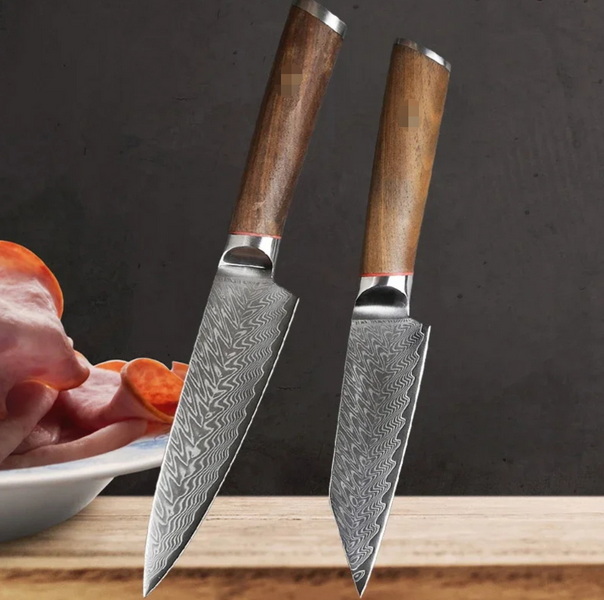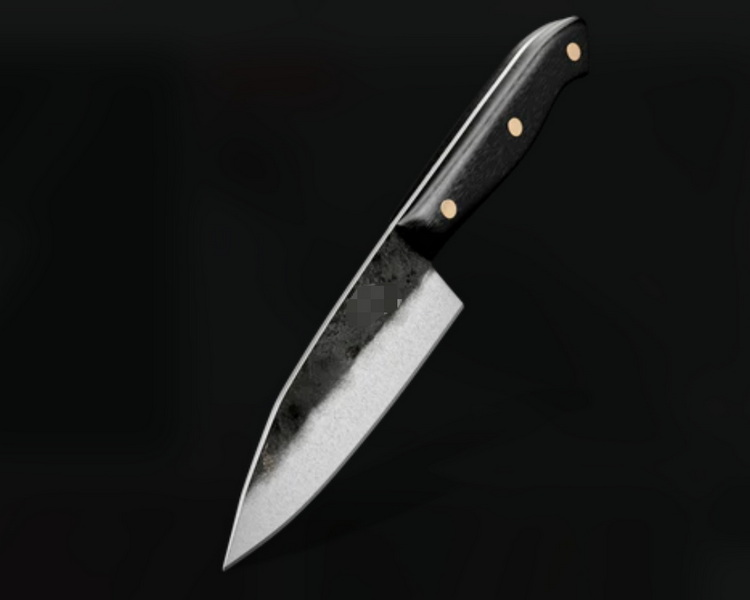- All
- Product Name
- Product Keyword
- Product Model
- Product Summary
- Product Description
- Multi Field Search
Views: 222 Author: Ann Publish Time: 2025-10-20 Origin: Site











Content Menu
● Understanding Damascus Steel
>> Key Features of Damascus Steel:
● The Relationship Between Hardness and Edge Retention
>> Why Hardness Matters for Damascus Knives
● Manufacturing Damascus Knives: The Making Process
>> Step 1: Assembling the Billets
>> Step 2: Heating and Forging
>> Step 4: Heat Treatment and Tempering
>> Step 5: Etching the Pattern
● Hardness Ranges and Their Practical Implications
● How Damascus Knife Hardness Affects Edge Retention
● Maintaining Your Damascus Knife for Longevity
● Frequently Asked Questions (FAQs)
>> 1. What hardness level is ideal for Damascus kitchen knives?
>> 2. Are harder Damascus knives always better?
>> 3. How does the Damascus forging process impact hardness?
>> 4. How should I maintain my Damascus knife to retain hardness?
>> 5. Can Damascus knives be sharpened at home?
Damascus knives have fascinated chefs and knife enthusiasts for centuries, celebrated not only for their striking, flowing patterns but also for their exceptional cutting performance. Central to this performance is the knife's hardness, which directly impacts its edge retention, durability, and how the knife performs in everyday use. This comprehensive guide delves into the nuances of Damascus knife hardness, its relationship to edge retention, and the best maintenance and manufacturing practices that ensure quality and longevity.

Damascus steel is identifiable by its iconic wavy, watery, or floral patterns, which emerge from a unique manufacturing process of layering and forging different types of steel together. Typically, these layers are folded and hammered repeatedly, forging a billet with alternating steel types, often combining high-carbon steels with softer, more flexible steels.
- Pattern: The characteristic layered “damask” pattern.
- Composition: Layers of differing steels—usually a mixture of high-carbon steels and softer alloys.
- Hardness: Usually ranges from 52 to 60 on the Rockwell Hardness Scale (HRC).
- Durability: Offers toughness and moderate corrosion resistance; proper care is necessary to prevent rust.
This layering process not only creates the dramatic pattern but enhances the blade's mechanical properties, such as combining hardness for sharpness with flexibility to resist breaking.
The hardness of a knife blade is a measure of how resistant the steel is to deformation, chipping, or wear. Hardness is quantitatively expressed through the Rockwell Hardness Scale (HRC), where a higher number indicates harder steel.
Hardness and edge retention are closely linked but must be balanced:
- Edge Retention: Harder steels typically hold an edge longer between sharpenings.
- Brittleness: Excessively hard steels can become brittle, increasing the risk of chipping or cracking.
- Ease of Sharpening: Softer steels sharpen more easily but need more frequent maintenance.
Damascus knives are often forged to a hardness between 55 and 62 HRC, ideal for kitchen and utility use. This range provides a balanced performance, where the blade is hard enough to maintain a sharp edge but not so brittle that it loses durability.
The creation of Damascus steel knives is an intricate craft involving multiple steps to combine aesthetics with functionality:
Steel plates of different compositions—primarily high carbon steel combined with low carbon or alloy steels—are cut to size and stacked. This stack is the raw material for Damascus forging.
The stack is heated to high temperatures (around 1500 to 2000°F), then hammered and folded repeatedly. This folding process can repeat dozens to hundreds of times to create hundreds of distinct layers, giving Damascus its famous pattern.
After forging the layered billet, the blade is shaped and ground to its final profile. Edges are precisely formed, and final details like bevels and tang are added.
Heat treatment involves heating the blade to non-magnetic temperatures, quenching it in oil or water, and tempering at around 350°F. This thermal cycling raises the hardness and toughness of the steel, ensuring longevity.
To reveal the pattern, the blade undergoes chemical etching using acids such as ferric chloride. This selectively darkens specific layers, accentuating the contrast and delivering the iconic look.
Throughout these stages, careful control and quality assurance ensure consistent hardness and excellent edge retention.

| Hardness (HRC) | Application | Pros | Cons |
|---|---|---|---|
| 52-55 | Utility knives, outdoor use | Very tough, less chipping | Requires frequent sharpening |
| 56-59 | Most kitchen knives | Balanced edge retention and toughness | Moderate sharpening effort |
| 60-62 | Premium kitchen knives, collectors | Sharpest edge, long-lasting | Greater brittleness risk |
Choosing the right hardness depends on the intended use, whether for professional kitchens, heavy-duty work, or display.
Edge retention is the blade's ability to maintain sharpness during use. Harder Damascus knives with well-crafted blades and heat treatments offer superior edge retention compared to steel types of similar or lesser hardness. The layered steel provides a combination of hardness for cutting edges and softer layers that absorb shock, which enhances durability.
- Always clean immediately after use with mild soap and water.
- Dry thoroughly to prevent rust.
- Apply a thin coat of mineral oil or knife-specific oil to stave off corrosion.
- Use appropriate sharpening stones such as whetstones or diamond stones.
- Maintain sharpening angles typically between 15° and 20°.
- Hone regularly using leather strops to realign edges.
- Do not cut on hard surfaces like glass or stone.
- Avoid twisting or prying motions that stress the blade.
Damascus knives are prized not just for their mesmerizing patterns but for their excellent hardness and edge retention properties. Their layered steel construction and meticulous heat treatment strike an optimal balance between sharpness and toughness, making them an indispensable tool in kitchens worldwide. Proper care, maintenance, and understanding of hardness levels are essential to maximize the performance and lifespan of these exquisite knives.

A range of 55 to 62 HRC is optimal, balancing edge retention and blade toughness suitable for kitchen tasks.
Not always. While harder blades hold edges longer, they may be brittle and prone to chipping, requiring cautious use.
The layering and repeated folding create a blade that combines different steel hardnesses, enhancing overall strength and edge life.
Clean and dry immediately after use, oil regularly to prevent rust, and sharpen with proper tools at correct angles.
Yes, with suitable sharpening stones and care, home sharpening is possible, though professional sharpening ensures the best results.
The Ultimate Professional Knives for Halal Butchery in Middle Eastern Kitchens
Chef Knife Size Guide: Choosing Between 6″, 8″, 10″, And 12″
Custom Knife Handles: How To Design A Chef Knife That Fits Your Hand Perfectly
Chef Knife Surface Treatments Guide: From Polished Migaki To Damascus Patterns
Inside Our Professional Knife Sample Room: Quality You Can See
Universal Knife Block Buying Guide: Modern Acrylic & ABS Knife Holders for Professional Kitchens
Universal Knife Block: The Complete Guide To Modern, Hygienic Knife Storage
The Complete Guide To Red Handle Knife Sets: Style Meets Functionality in The Kitchen
Professional Knives for Halal Butchery And Middle Eastern Cuisine